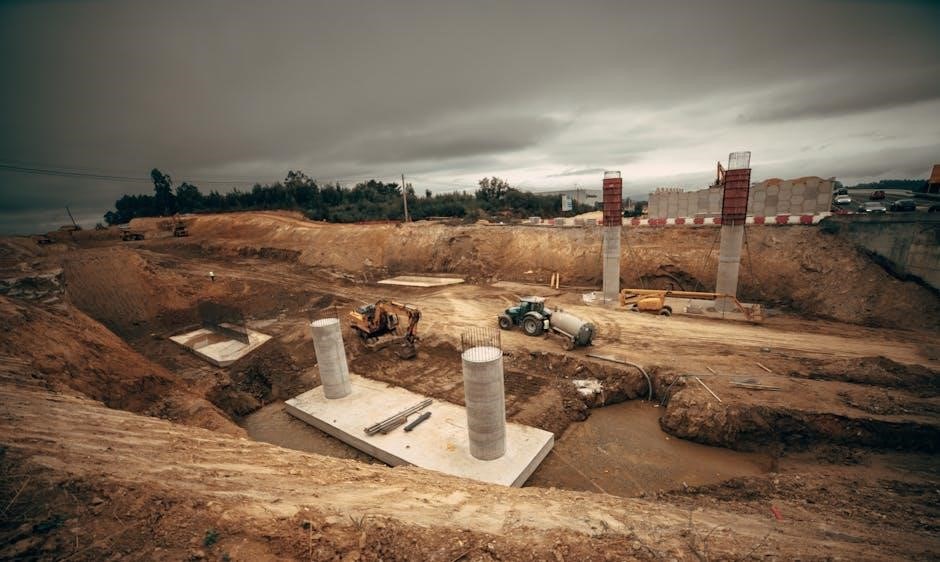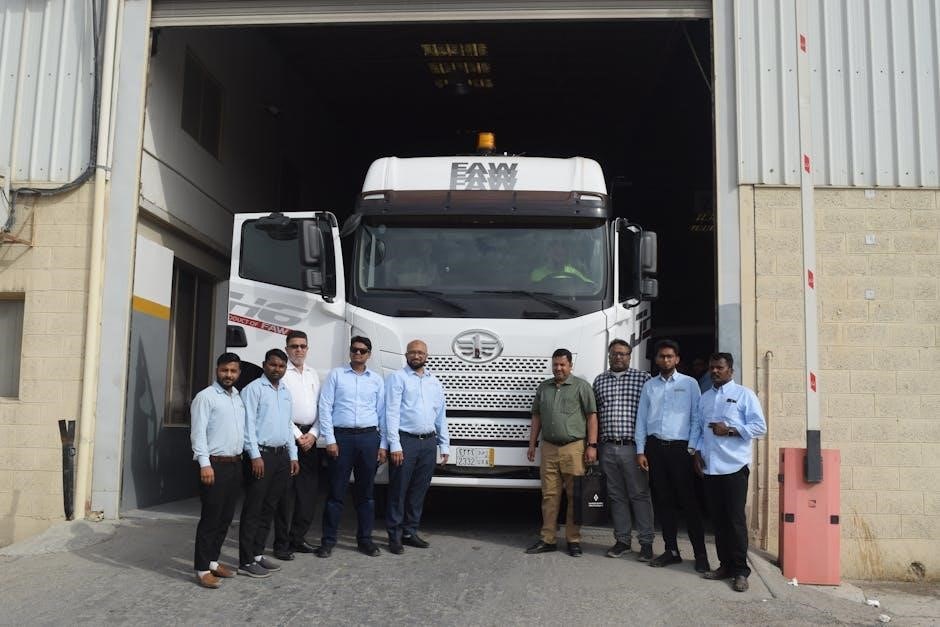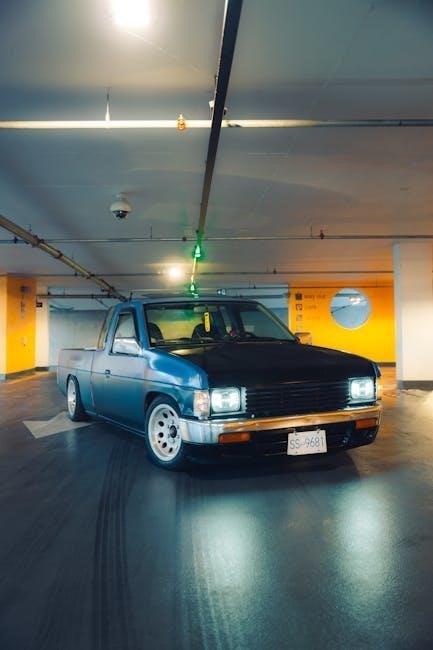Concrete mixer trucks are essential in construction, requiring precise dimensional measurements to ensure efficient mixing, transportation, and on-site delivery of fresh concrete․
Overview of Concrete Mixer Trucks
Concrete mixer trucks are robust vehicles designed to mix and transport fresh concrete to construction sites․ They typically range in length from 20 to 40 feet, with capacities varying between 6 to 14 cubic yards․ These trucks feature a rotating drum that continuously mixes cement, water, and aggregates during transit․ Equipped with essential components like water systems, control panels, and discharge chutes, they ensure precise mixing and efficient delivery․ Their design and dimensions are tailored for durability and performance, making them indispensable in modern construction․
Importance of Understanding Dimensions

Understanding the dimensions of concrete mixer trucks is crucial for safe and efficient operations․ Proper measurements ensure easy navigation through construction sites, avoiding obstacles and tight spaces․ Accurate dimensions also aid in complying with road regulations and weight limits, preventing potential legal issues․ Additionally, knowing the truck’s size helps in planning deliveries and ensures the correct amount of concrete is transported․ This knowledge is vital for optimizing logistics and maintaining workplace safety, making it a cornerstone of successful construction projects․

Types of Concrete Mixer Trucks
Concrete mixer trucks vary in configuration, including front and rear discharge models, with axle options ranging from two to four, each tailored for specific construction needs․
Front Discharge vs․ Rear Discharge Mixer Trucks
Front discharge mixer trucks feature a chute at the front, allowing drivers to monitor the pouring process, ideal for tight spaces․ Rear discharge models, with chutes at the back, offer larger drum capacities and are better suited for large-scale projects․ Front discharge trucks are more maneuverable but typically hold less concrete, while rear discharge trucks prioritize volume and efficiency, making them a popular choice for high-demand construction sites․ Each design caters to specific needs, ensuring optimal performance in varying environments․
Two-Axle, Three-Axle, and Four-Axle Mixer Trucks
Two-axle mixer trucks are lightweight and maneuverable, ideal for small projects, with payloads up to 12 cubic yards․ Three-axle trucks offer higher capacities, typically 14-16 cubic yards, and better stability for medium-scale construction․ Four-axle trucks are heavy-duty, handling up to 18 cubic yards, designed for large projects and rough terrains․ Each axle configuration balances weight distribution, payload, and site accessibility, ensuring efficient concrete delivery across various construction environments․
Standard Dimensions of Concrete Mixer Trucks
Concrete mixer trucks typically range from 20 to 30 feet in length, 8 to 9․5 feet in width, and 11 to 13․5 feet in height, varying by model and capacity․
Length, Width, and Height Specifications
Concrete mixer trucks typically measure between 20 to 40 feet in length, depending on the model and capacity․ The width generally ranges from 8 to 9․5 feet, while the height is usually between 11 to 13․5 feet․ These dimensions ensure efficient mixing and transportation of concrete while adhering to road safety standards․
The precise measurements vary slightly for front and rear discharge models, but overall, these specifications are crucial for navigating construction sites and ensuring safe, efficient delivery of fresh concrete․
Wheelbase and Axle Configuration
Concrete mixer trucks feature varying axle configurations, including two-, three-, and four-axle setups, each offering distinct stability and maneuverability benefits․ The wheelbase typically ranges from 11․6 to 15․5 meters, depending on the model and capacity․ Two-axle trucks are more compact, while four-axle models provide greater weight distribution and stability, especially for larger loads․ Proper axle configuration ensures safe operation and efficient concrete transportation on construction sites, adapting to different project requirements and road conditions effectively․

Capacity and Weight Regulations
Concrete mixer trucks typically have capacities ranging from 6 to 14 cubic yards, with loaded weights up to 40,000 pounds, adhering to strict regulations for safe operation․
Cubic Yard Capacities and Weight Limits
Concrete mixer trucks typically have capacities ranging from 6 to 14 cubic yards, depending on the model and type․ The weight limits vary significantly when loaded, often reaching up to 40,000 pounds․ These specifications ensure safe transportation and compliance with road regulations․ Proper understanding of these capacities is crucial for efficient project planning and optimal resource allocation on construction sites․ Adhering to weight limits also enhances safety and reduces wear on both the vehicle and infrastructure․
Operational Weight and Safety Standards
Concrete mixer trucks must adhere to strict operational weight and safety standards to ensure safe and efficient performance․ The curb weight typically ranges from 18,000 to 26,000 pounds, increasing significantly when loaded with concrete․ Safety features include reinforced drums, secure discharge systems, and operator controls for monitoring drum speed and direction․ Compliance with these standards is vital for preventing accidents, maintaining road safety, and prolonging equipment lifespan․ Regular maintenance and inspections further ensure adherence to operational guidelines and industry regulations․
Key Components of Concrete Mixer Trucks
Concrete mixer trucks feature a rotating drum, water systems, and control mechanisms; The drum mixes materials, while water systems ensure proper hydration․ Controls regulate drum speed․
Mixer Drum Dimensions and Material
The mixer drum is a critical component, typically made of durable steel with a thickness of 3/16 inch․ Capacities range from 7 to 14 cubic yards․ Drum dimensions vary by model, with lengths up to 12 feet and diameters optimized for mixing efficiency․ Material selection focuses on abrasion resistance, ensuring longevity․ The drum’s design includes spiral blades for consistent mixing․ Its size and material are tailored to handle heavy loads and maintain concrete quality during transit․
Water System and Control Mechanisms
The water system in concrete mixer trucks typically features a steel tank with extensions, ensuring precise water control during mixing․ Operators manage water flow and drum functions via intuitive controls located at the rear and in the cab․ These mechanisms allow for consistent drum speed and direction, crucial for maintaining mix quality․ LED lights enhance visibility, while the system’s design ensures efficient water usage and minimal waste․ Proper control mechanisms are vital for achieving the desired concrete consistency and slump․
Safety and Operational Considerations
Concrete mixer trucks require strict adherence to safety protocols, including drum rotation limits of 16 RPM and controlled feeding speeds of 2․7m/min to ensure safe operation and material handling․
Drum Rotation Speed and Discharge Rates
Drum rotation speed is critical for maintaining concrete consistency․ Trucks typically operate at 16 RPM to prevent segregation, with discharge rates optimized for even flow․ Proper feeding speeds of 2․7m/min ensure uniform mixing, avoiding overloading․ Discharge rates are balanced to match pouring requirements, often delivering 2-3 cubic yards per minute․ These parameters ensure safe, efficient, and high-quality concrete delivery on-site, minimizing delays and material waste while adhering to safety standards․ Operators must monitor these factors to maintain operational efficiency and concrete integrity․
Maximum Speed Limits for Safe Operation
Concrete mixer trucks have a maximum speed limit of 50 km/h to ensure safe transportation and prevent accidents․ The drum’s rotation speed is capped at 16 RPM during transit to maintain material stability․ Adhering to these limits reduces the risk of spillage and structural stress on the vehicle․ Operators must follow local regulations and drive cautiously, especially on uneven terrain or tight turns, to ensure the safety of both the crew and the surrounding environment while delivering fresh concrete efficiently․

Environmental and Efficiency Factors
Modern concrete mixer trucks prioritize fuel efficiency and reduced emissions, incorporating sustainable practices to minimize environmental impact while maintaining operational performance and concrete quality standards․
Fuel Efficiency and Emissions
Modern concrete mixer trucks emphasize fuel efficiency and lower emissions, featuring advanced engine technologies like the CURSOR 9 290, which optimizes performance while reducing environmental impact․ Lightweight materials and aerodynamic designs further enhance fuel economy, with some models achieving up to 12% reduction in fuel consumption․ Emission-reducing systems ensure compliance with environmental regulations, balancing operational efficiency with sustainability․ These advancements promote eco-friendly construction practices without compromising the trucks’ ability to deliver high-quality concrete efficiently;
Sustainable Practices in Concrete Mixing
Sustainable practices in concrete mixing involve optimizing water usage, reducing waste, and utilizing eco-friendly materials․ Mixer trucks often feature water recycling systems, minimizing excess water discharge․ Additionally, some models incorporate hybrid powertrains or electric drum drives, lowering emissions and energy consumption․ The use of advanced materials, like high-strength, lightweight drums, also contributes to fuel efficiency and reduced carbon footprints, aligning with global efforts to make construction more environmentally responsible while maintaining concrete quality and delivery efficiency․
Understanding concrete mixer truck dimensions is crucial for efficient construction operations, ensuring safety, and meeting project requirements while adapting to future environmental and technological advancements․
Concrete mixer trucks typically range from 20 to 30 feet in length, with widths around 9 to 10 feet and heights between 12 to 14 feet․ Capacities vary from 6 to 14 cubic yards, depending on the model․ Two-axle trucks are lighter, while four-axle models offer higher payloads․ Key features include drum thickness of 3/16 inches, steel construction, and water systems․ Drum speeds range from 16 to 18 RPM, ensuring consistent mixing․ These dimensions and features ensure efficient transport and delivery of fresh concrete to construction sites․
Future Trends in Concrete Mixer Truck Design
Future concrete mixer trucks may prioritize fuel efficiency and reduced emissions, incorporating hybrid or electric engines․ Autonomous technologies could enhance safety and precision in mixing and delivery․ Lightweight materials and optimized drum designs aim to increase payloads while minimizing wear․ Advanced telematics will improve monitoring and control, ensuring consistent mix quality․ Sustainable practices, such as recycling water and reducing waste, are expected to become standard, aligning with environmental regulations and industry demands for eco-friendly solutions․ These innovations will shape the next generation of mixer trucks․
